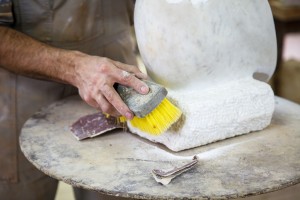Poisonous dust is on the agenda again
 Workplace dusts continue to present a serious hazard to British workers, killing hundreds of workers every year. Similarly, the expected peak in annual cases of asbestosis has still not been reached as the annual death toll continues to climb.
Workplace dusts continue to present a serious hazard to British workers, killing hundreds of workers every year. Similarly, the expected peak in annual cases of asbestosis has still not been reached as the annual death toll continues to climb.
Little surprise then that workplace dusts are in the news again.
A new industry collaboration to fight silicosis
Assisted by the Institution of Occupational Safety and Health (IOSH), several British industry representatives have agreed to work more closely to develop new approaches to controlling exposure to silica dust. The partnership will see experts from across a range of industries sharing experience and best practice knowledge.
Speaking about the new collaboration, IOSH director Shelley Frost said, “What was really clear is there are many examples of good practice across industry and that should be celebrated. Our responsibility is to break down the barriers that exist in sharing this across all industry.”
Also known as potter’s rot and miner’s phthisis, silicosis is one of the longest-known occupational diseases, and yet it continues to claim lives. Around 800 British workers die every year after developing illnesses related to inhaling silica dust, a figure that remains unacceptably high. Particularly as 900 new cases are diagnosed annually.
Asbestos in schools continues to threaten lives
Just like almost every other building constructed prior to 1999, most UK schools have asbestos present on site. The Joint Union Asbestos Committee (JUAC) believes that successive British governments have failed to tackle the issue, placing the health of students, teachers and other school employees at risk.
The JUAC is particularly concerned that boisterous behaviour – as is common in every school in the country – can cause asbestos dust trapped in ceilings and walls to be disturbed. If the dust is released into corridors or classrooms, the risk of inhalation increases exponentially.
Presenting their findings to the NUT conference, JUAC also claimed that many risk assessments carried out in schools were flawed. Reports released as a result of Freedom of Information requests found that risk assessments and tests were designed for adults used to working with asbestos, not children for whom exposure is even more dangerous.
The JUAC ended their presentation by urging the government to conduct a full nationwide survey of school building to properly document the presence of asbestos in each building. Without this definitive audit, it is impossible to properly plan for the future.
Dust and workplace risk assessments are critical
Every employer has a duty to protect their workers and the general public against potential exposure to hazardous dusts. This means conducting appropriate risk assessments tailored to the specific circumstances of those in danger.
For general workplace scenarios, employees may need to receive additional training to better manage their own exposure to harmful dusts. And if appropriate, they will need to be issued with PPE that can prevent them inhaling silica or asbestos.
For further help and advice on protecting your employees against exposure to poisonous dusts, or to arrange a specialist asbestos survey, please get in touch.

A chartered (fellow) safety and risk management practitioner with 20+ years of experience. David provides a healthy dose of how-to articles, advice and guidance to make compliance easier for construction professionals, Architects and the built environment. Get social with David on Twitter and Linkedin.




3 Comments
Once again no mention of wood dust, a type 1 carcinogen alongside asbestos since 1995. It is genotoxic and hazardous to health and known to cause allergic reactions, respiratory disease and cancer. Why is it being ignored?
Wood Dust is not being ignored it’s as an important as any hazardous substance that causes cancer. What sources of information do you have for a future Blog post.
Thanks for dropping by with your comments by the way
whilst the use of the correct PPE where appropriate is to be applauded the key is to where ever possible design out the risk in line with the HSE guidelines. No silica = no risk. The use of PPE requires the right kit, training & a willingness to actually use it. Ever seen someone cutting concrete without the correct PPE? Yes, me too.